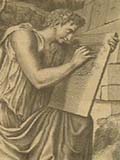Vitruvius & Fréart
Vitruvius
Although little is known about Vitruvius, a Roman writer and architect
of the 1st century B.C., his text of ten books remain the only surviving
architectural treatise from antiquity. A complete manuscript was rediscovered
in a monastery in 1414 and was later published in 1486, with an illustrated
edition being prepared in 1511. Through the Renaissance the text was perceived
as a seemingly authentic voice from antiquity and it provided the framework
for subsequent writing and critique of contemporary architectural theorists.
In the seventh book Vitruvius outlines Greek architectural theory. He
details the Doric, Ionic and Corinthian orders prescribing rules for proportion,
modules and ratios. This is the second edition of Vitruvius to be published
in France and it includes annotations by Guillaume Philander. The illustrations
in this edition have been tentatively attributed to Bernard Salomon or
to Sebastiano Serlio under whom Philander studied in Rome.
List of items
Links
Vitruvius'"The ten books on architecture" (in Latin)
Vitruvius'"The ten books on architecture" (in English)
Fréart 
Following a stay in Rome in 1650, Fréart de Chambray published
this anthology of ten ancient and modern writers on the classical orders.
He argues that the Greek orders (the Doric, the Ionic, and Corinthian)
are perfect models for all architecture and he condemns the Roman orders
(the Tuscan and the Composite) as being corrupt. Citing its use in the
Temple of Solomon, he declares the Corinthian order to be the ‘flower
of Architecture and the Order of Orders'. To Fréart de Chambray,
Vitruvius and his translators were beyond reproach.
List of items
|
|
|
| Detail. Fréart,
Roland, sieur de Chambray. A parallel of the antient architecture with the modern: in a collection of ten principal authors who have written upon the five orders ... Printed by Tho. Roycroft for John Place, 1664. |
|
